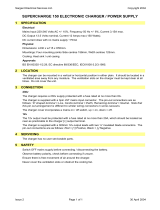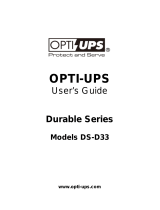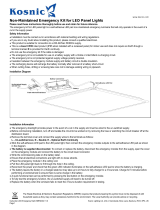Service Manual
Table of Contents
Prelim Page iiUPS Preliminary Pages
Issue 1 - May 2001
3.4 - Initial UPS Start-up. 3 - 4. . . . . . . . . . . . . . . . . . . . . . . . . . . . . . . . . . . . . . . . . . . . . . . . . . . .
3.4.1 - Converter and Inverter Output Calibration. 3 - 4. . . . . . . . . . . . . . . . . . . . . .
3.4.2 - Inverter to Bypass Synchronisation Check. 3 - 6. . . . . . . . . . . . . . . . . . . . .
3.4.3 - Battery Charger Output Calibration. 3 - 6. . . . . . . . . . . . . . . . . . . . . . . . . . . .
3.5 - Power Checks 3 - 7. . . . . . . . . . . . . . . . . . . . . . . . . . . . . . . . . . . . . . . . . . . . . . . . . . . . . . . . . .
3.5.1 - Bupass Failure Test 3 - 7. . . . . . . . . . . . . . . . . . . . . . . . . . . . . . . . . . . . . . . . . .
3.5.2 - Mains Failure Checks 3 - 7. . . . . . . . . . . . . . . . . . . . . . . . . . . . . . . . . . . . . . . .
3.5.3 - Test Transfer to the Reserve Line (Automatic Bypass). 3 - 8. . . . . . . . . . . .
3.5.4 - Manual Bypass Operation Check 3 - 9. . . . . . . . . . . . . . . . . . . . . . . . . . . . . .
3.5.5 - Local EPO 3 - 10. . . . . . . . . . . . . . . . . . . . . . . . . . . . . . . . . . . . . . . . . . . . . . . . . .
3.5.6 - External EPO 3 - 10. . . . . . . . . . . . . . . . . . . . . . . . . . . . . . . . . . . . . . . . . . . . . . . .
3.6 - Normal UPS Start-Up Instructions 3 - 11. . . . . . . . . . . . . . . . . . . . . . . . . . . . . . . . . . . . . . . .
3.6.1 - LCD Messages and LED status after starting the UPS. 3 - 12. . . . . . . . . . .
3.7 - Normal Shutdown to Manual Bypass 3 - 12. . . . . . . . . . . . . . . . . . . . . . . . . . . . . . . . . . . . . .
3.8 - Setting Options 3 - 14. . . . . . . . . . . . . . . . . . . . . . . . . . . . . . . . . . . . . . . . . . . . . . . . . . . . . . . . .
3.8.1 - Setting options on the Relay card 3 - 14. . . . . . . . . . . . . . . . . . . . . . . . . . . . . .
Chapter 4 - Operation and control4 - 1. . . . . . . . . . . . . . . . . . . . . . . . . . . . . . . . . . . .
4.1 - Operator Control Panel 4 - 1. . . . . . . . . . . . . . . . . . . . . . . . . . . . . . . . . . . . . . . . . . . . . . . . . .
Chapter 5 - Functional description 5 - 1. . . . . . . . . . . . . . . . . . . . . . . . . . . . . . . . . . . .
5.1 - Control Logic PCB CS0072 5 - 1. . . . . . . . . . . . . . . . . . . . . . . . . . . . . . . . . . . . . . . . . . . . . .
5.1.1 - Potentiometer adjustment 5 - 1. . . . . . . . . . . . . . . . . . . . . . . . . . . . . . . . . . . .
5.1.2 - Link and Jumper functions 5 - 1. . . . . . . . . . . . . . . . . . . . . . . . . . . . . . . . . . . .
5.2 - Auxiliary Supply PCB CS0070 5 - 2. . . . . . . . . . . . . . . . . . . . . . . . . . . . . . . . . . . . . . . . . . . .
5.2.1 - Battery Threshold settings 5 - 2. . . . . . . . . . . . . . . . . . . . . . . . . . . . . . . . . . . .
5.3 - Driver Interface PCB CS007I 5 - 3. . . . . . . . . . . . . . . . . . . . . . . . . . . . . . . . . . . . . . . . . . . . .
5.3.1 - Bypass Voltage Threshold Adjustment 5 - 3. . . . . . . . . . . . . . . . . . . . . . . . .
5.3.2 - Link and Jumper functions 5 - 3. . . . . . . . . . . . . . . . . . . . . . . . . . . . . . . . . . . .
5.4 - Battery Charger CS0074 5 - 4. . . . . . . . . . . . . . . . . . . . . . . . . . . . . . . . . . . . . . . . . . . . . . . . .
5.4.1 - Battery Charger Voltage Adjustment 5 - 4. . . . . . . . . . . . . . . . . . . . . . . . . . .
5.4.2 - Link and Jumper Functions 5 - 4. . . . . . . . . . . . . . . . . . . . . . . . . . . . . . . . . . .
5.4.3 - Battery test 5 - 5. . . . . . . . . . . . . . . . . . . . . . . . . . . . . . . . . . . . . . . . . . . . . . . . .
5.5 - UPS monitor board PCB CS0077 5 - 5. . . . . . . . . . . . . . . . . . . . . . . . . . . . . . . . . . . . . . . . .
5.6 - Relay Interface PCB CS0082 5 - 6. . . . . . . . . . . . . . . . . . . . . . . . . . . . . . . . . . . . . . . . . . . . .
5.6.1 - EPO Connections. 5 - 6. . . . . . . . . . . . . . . . . . . . . . . . . . . . . . . . . . . . . . . . . . .
5.6.2 - Optional Second Relay Interface PCB 5 - 6. . . . . . . . . . . . . . . . . . . . . . . . . .
5.7 - LCD MIMIC DISPLAY CS0075 5 - 8. . . . . . . . . . . . . . . . . . . . . . . . . . . . . . . . . . . . . . . . . . . .
5.7.1 - Control panel indicator LEDs 5 - 8. . . . . . . . . . . . . . . . . . . . . . . . . . . . . . . . . .
Chapter 6 - Maintenance 6 - 1. . . . . . . . . . . . . . . . . . . . . . . . . . . . . . . . . . . . . . . . . . . . .
6.1 - Scheduled Maintenance 6 - 1. . . . . . . . . . . . . . . . . . . . . . . . . . . . . . . . . . . . . . . . . . . . . . . . .
6.1.1 - Daily Checks 6 - 1. . . . . . . . . . . . . . . . . . . . . . . . . . . . . . . . . . . . . . . . . . . . . . . .
6.1.2 - Weekly Checks 6 - 1. . . . . . . . . . . . . . . . . . . . . . . . . . . . . . . . . . . . . . . . . . . . . .
6.1.3 - Annual Maintenance 6 - 2. . . . . . . . . . . . . . . . . . . . . . . . . . . . . . . . . . . . . . . . .
6.2 - Battery Maintenance 6 - 6. . . . . . . . . . . . . . . . . . . . . . . . . . . . . . . . . . . . . . . . . . . . . . . . . . . .
6.2.1 - Factors Effecting Battery Use 6 - 6. . . . . . . . . . . . . . . . . . . . . . . . . . . . . . . . .
6.2.2 - Battery Testing 6 - 7. . . . . . . . . . . . . . . . . . . . . . . . . . . . . . . . . . . . . . . . . . . . . .
























